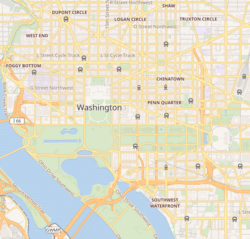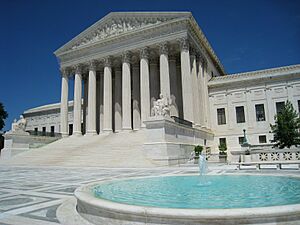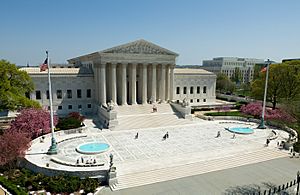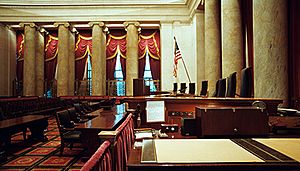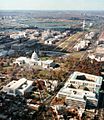United States Supreme Court Building facts for kids
Quick facts for kids |
|
|
Supreme Court Building
|
|
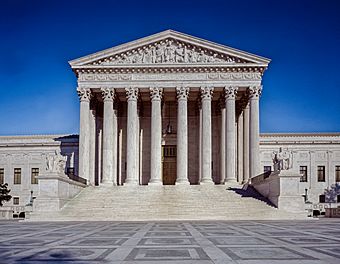
West Façade
|
|
| Location | 1 First Street, Northeast Washington, D.C. |
|---|---|
| Built | 1932–1935 |
| Architect | Cass Gilbert, Cass Gilbert Jr. |
| NRHP reference No. | 87001294 |
| Designated NHL | May 4, 1987 |
The Supreme Court Building is where the Supreme Court of the United States works. It's sometimes called "the Marble Palace" because of its beautiful stone. This building is the official home and workplace for the Chief Justice of the United States and the eight other Justices.
You can find it at 1 First Street in Northeast Washington, D.C.. It's right next to the United States Capitol and close to the Library of Congress. The Architect of the Capitol takes care of the building. On May 4, 1987, the Supreme Court Building was named a National Historic Landmark. This means it's a very important historical place.
The idea for a separate building for the Supreme Court came from President William Howard Taft in 1912. He later became the Chief Justice in 1921. In 1929, Taft successfully argued that the Court needed its own building. Sadly, he passed away before it was finished. Construction started in 1932 and was completed in 1935. Chief Justice Charles Evans Hughes, who took over after Taft, oversaw its completion. The building was designed by architect Cass Gilbert, a friend of Taft's.
Contents
History of the Supreme Court Building
Before Washington, D.C., became the capital, the U.S. government was in New York City. The Supreme Court met there in the Merchants Exchange Building. When the capital moved to Philadelphia, Pennsylvania, the Court moved too. They met in Independence Hall and then in Old City Hall until 1800.
When the federal government moved to Washington, D.C., the Court didn't have a permanent home until 1810. They moved into what is now called the Old Supreme Court Chamber inside the United States Capitol. They stayed there until 1935. The only time they left was from 1812 to 1819. This was because the British attacked Washington and burned parts of the Capitol during the War of 1812.
In 1860, the Supreme Court moved to the Old Senate Chamber within the Capitol. This happened after new parts of the Capitol were built for the Senate and the House of Representatives. The Court stayed in the Old Senate Chamber until its own building was ready in 1935.
Why a New Building Was Needed
From 1860 to 1935, the Supreme Court Justices worked in the small, crowded Old Senate Chamber. This space was shared with other government workers. Because of these conditions, many Justices preferred to work from their homes.
Charles Evans Hughes, who was a Justice before becoming Chief Justice, often spoke about how bad the working conditions were. He said the Old Senate Chamber was small, hot, and plain.
Chief Justice Taft worked very hard to get money from Congress for a new Supreme Court building in 1929. Taft wanted the judicial branch to be seen as independent from the other branches of government. He believed a grand building would show this independence.
The Supreme Court building was finally completed thanks to the efforts of Charles Evans Hughes. He became Chief Justice after Taft in 1930.
Who Didn't Want a New Building?
Not everyone thought a new Supreme Court building was a good idea. Chief Justice Edward Douglass White, who Taft appointed in 1910, was against it at first. He thought the Court was important because it was located inside the Capitol. Many Justices, including Chief Justice White, chose to work from their homes instead of the new building. They were used to their home offices and even received money from Congress to work there.
Justices Harlan Fiske Stone and Louis Brandeis never moved into the new building while they served. Brandeis felt that Taft's idea for a new building showed a conflict between the judicial branch and the other parts of government. He suggested adding a new part to the Capitol instead. However, Taft kept pushing for his vision.
About ten years after the building was finished, all nine Justices had offices there. This was mainly because the Justices who didn't like the new building were replaced by new ones. These new Justices were not used to working from home.
The main opposition to the building came from Congress, especially when Taft was Chief Justice. Some senators, like Senator Charles Curtis, even threatened Taft if he kept complaining about his working conditions. In 1927, Taft noted that only one out of ninety-six senators truly supported his efforts. This senator only wanted the space the Justices were using for the Senate.
The Temple of Justice: Design and Features
The Supreme Court Building is at 1 First Street, NE. It sits across the street from the United States Capitol. Architect Cass Gilbert designed it. This was his last major project, and he died before it was finished. Gilbert was a good friend of William Howard Taft. Chief Justice Taft personally chose Gilbert to design the building. Gilbert wanted the building to show the importance of law.
The building is in the Neoclassical style, which looks like ancient Greek and Roman buildings. It is four stories tall. The first stone was laid on October 13, 1932. Construction finished in 1935, costing just under the $9,740,000 budget. The building was designed to show how important the Court and the Judiciary are as an independent part of the U.S. government.
The front of the building, facing the public, is made of marble from Vermont. The parts of the building that don't face the public are made of marble from Georgia. Most of the inside is lined with Alabama marble. However, the Courtroom itself uses Spanish ivory vein marble. For the 24 columns in the Courtroom, Gilbert wanted special golden marble from Italy. He even asked the Italian Prime Minister, Benito Mussolini, for help to make sure the best marble was sent.
Not all the Justices loved the new building. Justice Harlan Fiske Stone said it was "too showy" and "not right for a quiet group of old boys." Another Justice joked that they would look like "nine black beetles in the Temple of Karnak." Someone else complained that it was so grand, the Justices should enter riding on elephants!
The west side of the building has the words "Equal Justice Under Law" carved into it. The east side has "Justice, the Guardian of Liberty." In 2005, a large piece of marble fell from the west side. It weighed about 172 pounds! After this, the west side was repaired and cleaned.
The Supreme Court Building has many different areas:
- Basement: This floor has maintenance areas, a garage, and a mailroom.
- First (or ground) floor: Here you'll find the public information office, the clerk's office, exhibit halls, a cafeteria, a gift shop, and other offices.
- Second floor: This floor has the Great Hall, the main Courtroom, the conference room, and most of the Justices' offices.
- Third floor: This floor has some Justices' offices, the legal office, and offices for the law clerks. The Justices' dining and reading rooms are also here.
- Fourth floor: This floor holds the Court library.
- Fifth floor: This floor has the Supreme Court gym, which includes a basketball court. It's even called the "Highest Court in the Land"!
The gym was originally a storage area but was changed into a gym in the late 1940s. Some people think Cass Gilbert, Jr., the architect's son, suggested it. Justice Byron White, who was a famous football player, was known for his skills on the basketball court. Some Supreme Court clerks and current Justices Elena Kagan and Brett Kavanaugh have also played there. There's a sign near the gym that says, "PLAYING BASKETBALL AND WEIGHT LIFTING ARE PROHIBITED WHILE THE COURT IS IN SESSION."
The building's roof is made of terra cotta from New Jersey.
The Supreme Court Building has its own police force, called the Supreme Court Police. They were created in 1935 to protect the building and its staff.
Art and Sculptures
The building's design includes many sculptures of real and symbolic figures.
- The bases of the flagpoles and the bronze doors on the east and west sides were made by John Donnelly.
- The East pediment (the triangular part above the entrance) shows Justice, the Guardian of Liberty by Hermon Atkins MacNeil.
- The West pediment shows Equal Justice Under Law by Robert Ingersoll Aitken. This sculpture even includes a portrait of Cass Gilbert!
- Two large statues stand outside: The Authority of Law on the south side and The Contemplation of Justice on the north side, both by James Earle Fraser.
- In the Great Hall, there are busts (head and shoulders sculptures) of every Chief Justice.
- The Courtroom has friezes (long bands of sculptures) on its walls. The South Wall Frieze shows important lawgivers from ancient times, like Moses and Hammurabi. The North Wall Frieze shows lawgivers from later periods, like Justinian and Napoleon. The Moses frieze shows him holding the Ten Commandments.
In 1997, a group asked for the image of Muhammad to be removed from the frieze. They explained that Islam discourages pictures of Muhammad. They also didn't like that he was shown with a sword. Chief Justice William Rehnquist said no to the request. He explained that the artwork was meant to honor Muhammad as an important figure in law history, not as a form of worship. The Court later added a note to tourist guides explaining this.
Visiting the Building
Since 2010, visitors can no longer enter the building through the main doors at the top of the steps. This change was made for security reasons. Now, everyone must enter through ground-level doors for security checks. You can still use the main doors to exit. Justice Stephen Breyer, along with Justice Ginsburg, disagreed with closing the main entrance. He felt it was "disheartening" and didn't know of any other Supreme Court in the world that closed its main entrance to the public.
All visitors must go through metal detectors and have their bags X-rayed. You can bring cameras into the building, but you can't record anything (audio or video) in the Courtroom.
When the Court is not in session, you can walk through the Great Hall and public areas on the ground floor. This includes the cafeteria and a small movie theater that shows a film about the Court. Guided talks are sometimes given in the Courtroom, but you can't go in otherwise. You can check the Court's website for lecture schedules.
When the Court is in session, the Great Hall is only open to those attending Court. Arguments usually happen in two-week cycles on Mondays, Tuesdays, and Wednesdays. If you want to watch an argument, you should arrive early. For very important cases, people might even wait overnight! Supreme Court Police Officers give out numbered tickets. These tickets hold your place in line but don't guarantee entry. The Courtroom has seats for about 250 public visitors. However, large groups of students or officials often take up many seats. Visitors who get in for the first argument usually stay for the second, so fewer seats are available later.
Just before the first argument, officers divide the crowd into two lines. One line is for those who want to watch the entire argument. The other line is for those who want to watch for just five minutes while standing in the back. Visitors must stand when the Justices enter and leave. You must be completely silent. If you are sleepy, noisy, or cause any trouble, officers will quickly remove you.
Since recording devices are not allowed in the courtroom, the fastest way for news about important decisions to reach the press is through the "Running of the Interns." This is when interns quickly carry the news outside to reporters.
Images for kids
-
The Supreme Court courtroom interior with its Siena marble.
See also
 In Spanish: Edificio de la Corte Suprema de los Estados Unidos para niños
In Spanish: Edificio de la Corte Suprema de los Estados Unidos para niños


